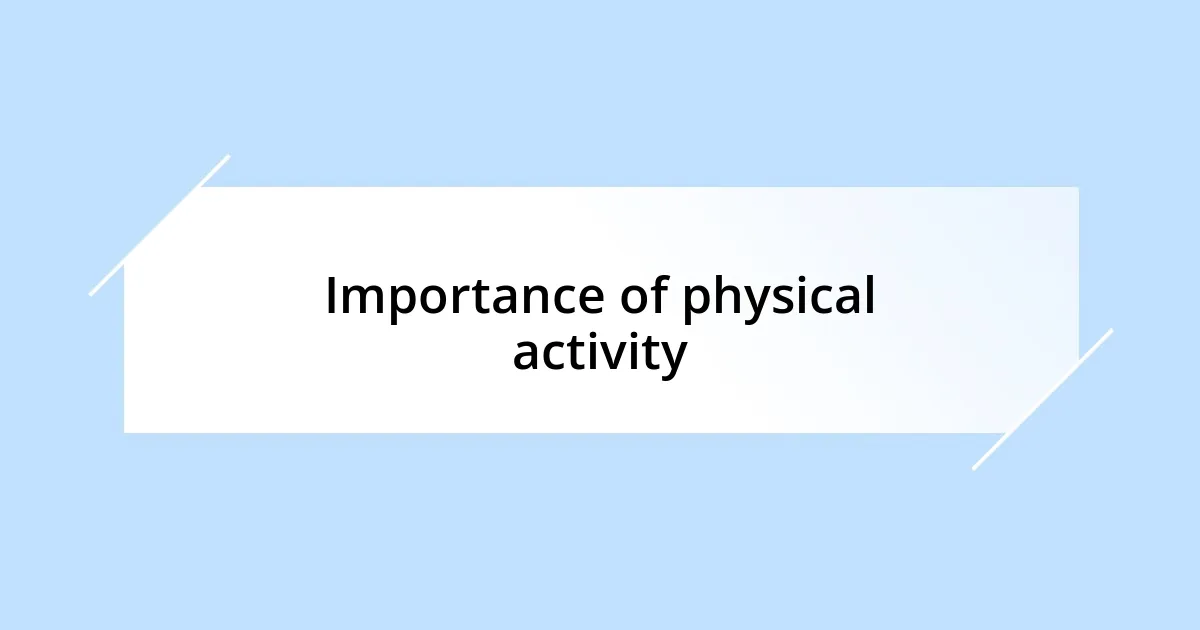Key takeaways:
- Recognizing personal stress triggers, such as public speaking and cluttered environments, is crucial for effective stress management.
- Engaging in physical activities, like walking or yoga, helps elevate mood and reduce stress through endorphin release and mindfulness.
- Incorporating mindfulness practices, including gratitude reflection and focused breathing, leads to greater emotional awareness and resilience to stress.
- Creating a supportive environment through decluttering, open communication, and celebrating small wins can significantly enhance well-being and reduce stress.

Understanding stress in daily life
Stress often feels like a constant companion in our daily lives, doesn’t it? I’ve found that the little things—traffic jams, tight deadlines, or even a messy kitchen—can add up and create a heavy burden. Some days I wake up feeling fine, only to be hit by stressors before I’ve even finished my morning coffee.
Interestingly, I sometimes notice that my stress levels rise when I’m juggling multiple tasks at once. Do you ever feel overwhelmed by to-do lists that seem endless? I remember a day when I tried to squeeze in work, errands, and a workout, only to discover that my mind was racing while my body felt exhausted. It’s a tough balancing act, and recognizing the signs of stress can be the first step towards managing it.
As I navigate through my day, I often have to remind myself that it’s okay to pause and breathe. I’ve learned that it’s essential to check in with myself and acknowledge how I’m feeling. How about you? Do you take moments to reflect on your emotional state? Emotions are signals, and understanding them can empower us to handle stress more effectively in our everyday lives.

Identifying personal stress triggers
Identifying personal stress triggers can be an eye-opening experience. I remember the first time I wrote down the situations that consistently stressed me out. It was surprising to see that things like public speaking and even certain types of social gatherings were at the top of the list. Recognizing these triggers helped me develop strategies to manage my reactions.
Sometimes, stress sneaks up on us, disguised as something we might not expect. For instance, a friend’s criticism about a project I was passionate about hit me harder than I anticipated. Reflecting on that moment led me to understand my sensitivity to feedback and how it could impact my stress levels. Have you ever noticed a similar pattern in your life? It’s fascinating how self-awareness can illuminate the reasons behind our stress.
I’ve also found that certain environments elevate my stress more than others. For example, working in a cluttered space can distract me, causing my anxiety to spike. I now prioritize organizing my workspace to minimize those external stressors. Understanding what triggers my stress has given me greater control, allowing me to create a more conducive environment for productivity and peace of mind.
| Trigger | My Reaction |
|---|---|
| Public Speaking | Increased anxiety, sometimes sleepless nights before an event |
| Negative Feedback | Feelings of self-doubt and frustration |
| Cluttered Work Environment | Distraction and overwhelm, leading to procrastination |

Practical techniques for stress relief

Practical techniques for stress relief
When stress starts to pile up, I lean on a few practical techniques that help me find my center. One of my favorite methods is mindful breathing. Just a few minutes of focused breathing can shift my state of mind. I simply close my eyes, inhale deeply through my nose for a count of four, hold it for four, and then exhale through my mouth for six. This rhythm grounds me in the present moment and dissolves the chaos swirling around me.
Another technique I’ve discovered is the power of movement. Whether it’s a brisk walk or a quick session of stretching, getting my body moving releases endorphins, which naturally elevate my mood. There’s something liberating about feeling the tension slip away with each stride or stretch. Find what resonates with you; everyone’s different, and that’s the beauty of it.
- **Mindful Breathing:** Take a moment to focus on your breath, inhaling deeply and exhaling fully. I often do this before a potentially stressful meeting, and it helps clear my head.
- **Physical Activity:** Even a short walk can make a world of difference. I often step outside for five minutes, feeling the fresh air work wonders on my stress levels.
- **Journaling:** Writing about my feelings has been therapeutic. It’s like unloading my thoughts onto paper, giving my mind the space to breathe.
- **Progressive Muscle Relaxation:** Tensing and then relaxing each muscle group helps me notice where I hold stress. I sometimes find I’m surprised at how tense I can get just sitting at my desk!
- **Creative Outlets:** Drawing or painting allows me to express my feelings visually. I never thought I was an artist, but it brings a unique kind of clarity and satisfaction.

Importance of physical activity
Engaging in physical activity has become a cornerstone of my stress management toolkit. I’ve noticed that even a simple, brisk walk can transform my mood almost instantly. There was a particularly overwhelming week when deadlines loomed large, and I made it a point to step outside for a quick 10-minute walk each day. The fresh air and a change of scenery made a noticeable difference in my mindset. It’s as if each step lifted a weight off my shoulders—have you ever experienced that feeling?
What amazes me is how physical activity stimulates the production of endorphins, often referred to as the body’s natural mood lifters. I remember deciding to try yoga on a particularly anxious day. Not only did it challenge my balance and flexibility, but it also provided a calming focus. The combination of movement and mindfulness made the stress melt away, leaving me feeling recharged. I found myself thinking, “Why hadn’t I embraced this sooner?”
Moreover, the social aspect of group exercises, like joining a local fitness class, adds another dimension of stress relief. Beyond the physical benefits, sharing the experience with others fosters a sense of belonging. Recently, I joined a hiking group, and not only did I enjoy the beautiful trails, but I also connected with people who shared similar interests. It’s incredible how moving together can lift both spirit and stress. How about you? Have you ever thought about combining social connections with physical activity? It really can make a world of difference.

Benefits of mindfulness practices
Mindfulness practices have profoundly shaped my approach to stress management. One of the key benefits I’ve experienced is the clarity that comes from being fully present. In moments of chaos, simply sitting quietly, focusing on my breath, and letting thoughts drift away helps clear the mental fog. It’s like an instant reset button for my mind, allowing me to approach challenges with renewed perspective.
I’ve also noticed how mindfulness cultivates a deeper awareness of my emotions. For example, when I practice mindfulness during my morning routine, I often find myself processing feelings I didn’t even realize I was holding onto. It’s intriguing how tuning into the present moment can reveal underlying anxieties or stressors. I can then address those feelings rather than let them linger unnoticed. Have you ever found yourself discovering something about your emotions that you didn’t know before?
Moreover, incorporating gratitude into my mindfulness practice has been a game changer. Each evening, I take a moment to reflect on three positive moments from my day, no matter how small. This simple act transforms my perspective, fostering resilience against stress. I remember a particularly tough week when I made a conscious effort to highlight the little joys, and it truly shifted my mindset. It’s as if focusing on gratitude builds a protective layer against stress, reminding me that even in challenging times, there is always something to appreciate.

Creating a supportive environment
Creating a supportive environment is vital for managing stress, and I’ve found that surrounding myself with positive influences really makes a difference. For instance, I recently made a conscious effort to declutter my workspace, removing distractions and adding personal touches like photos of loved ones. Each time I sit down to work, those reminders of support and happiness help me feel grounded. Have you ever noticed how your surroundings can influence your mindset?
Another significant aspect of a supportive environment is open communication with friends and family. I remember reaching out to a close friend during a particularly stressful period, sharing my challenges and fears. That simple conversation not only lightened my emotional load but also reinforced our bond. It’s incredible how just opening up can create a sense of belonging and understanding—do you have someone you feel comfortable confiding in?
Moreover, celebrating small wins can foster a more positive atmosphere around us. Recently, I decided to acknowledge not just major achievements, but also everyday successes. For example, after completing an important project, I treated myself to a cozy night in with a good book. This positive reinforcement helped create an uplifting environment that nurtures my well-being. Have you thought about how rewarding yourself in small ways can shift your overall perspective?














